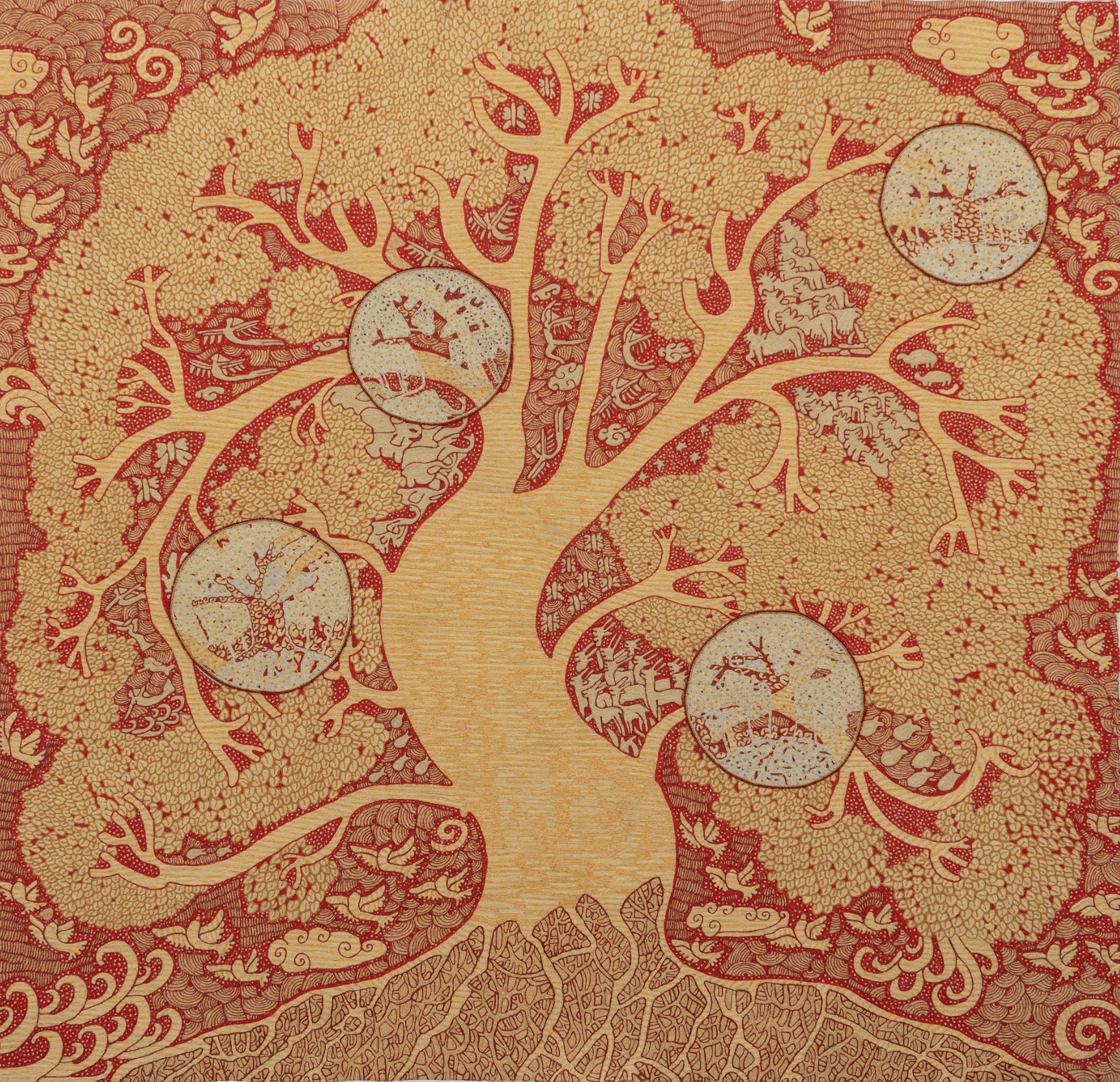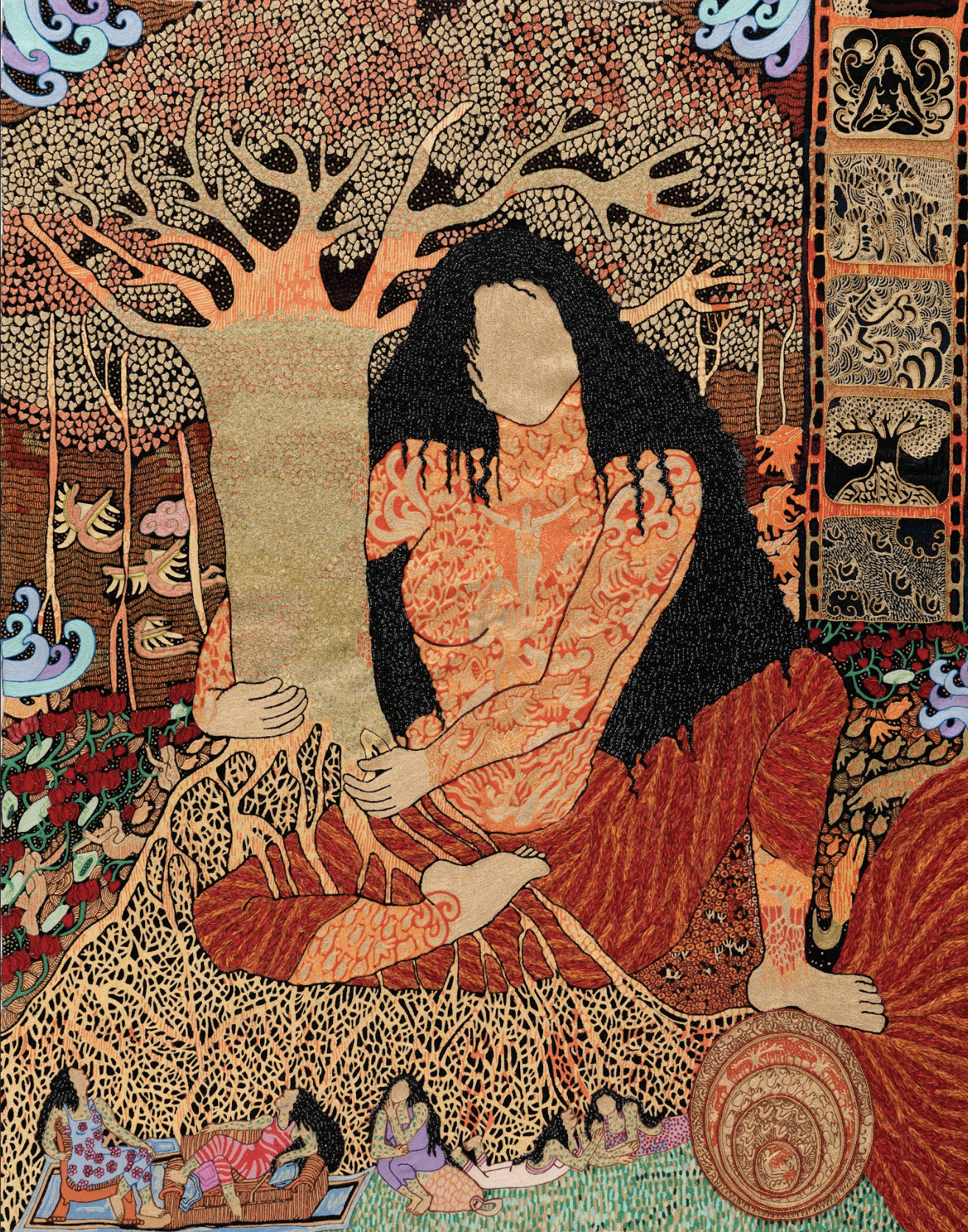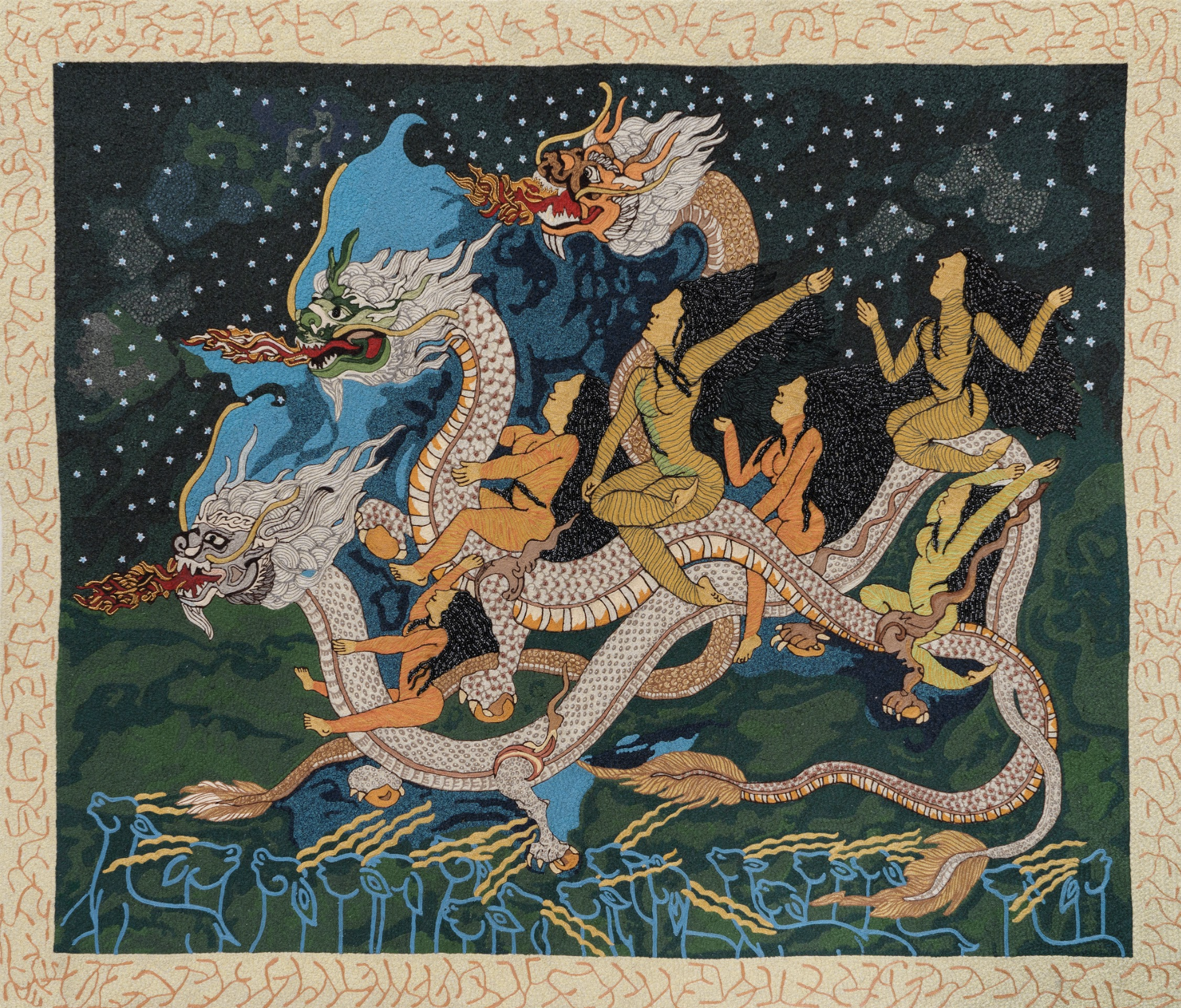The press release and curatorial essay for Seema Kohli’s latest exhibition follows a predictable path, connecting the dots between her work and conventional themes. However, such a narrow interpretation only skims the surface of her boundless conceptual potential, hindering the opportunity for profound exploration. In her solo show, Kohli delves into the cosmic energy of femininity and the mystical world of medieval bhakti saints, while also inviting introspection through her intricate blend of images, materials, textures, and labor. These elements not only raise pertinent questions about the creation of value in a commodified society, but also shed light on the persisting caste hierarchies within artisanal practices. Her exhibition also illuminates the complex dynamics that emerge when craft practices intersect with contemporary art.

The premises became a perfect architectural premise to set up the fantastical realm that Seema Kohli had envisioned for her audience. Both floors of the exhibition housed Kohli’s collaborative works with weavers, with each piece showcasing the meticulous craftsmanship and storytelling ability. Vibrant paintings adorned the walls, displaying intricate patterns woven with colorful threads that seemed to shimmer under the soft gallery lighting. The stories depicted in these visuals unfolded like ancient legends, capturing the essence of feminine cosmic energy. Besides showcasing these embroidered works, drawings, film, texts and performance, Seema also displayed a weaving loom and a charkha obtained from weavers in Panipat for an installation. The installation incorporated the distinct mechanical sounds of the loom as a representation of the never-ending cosmic creation that intricately connects us all together.

A lively discourse emerged between the artworks, borne out of an extensive partnership with the weavers of the Raj Art Initiative and the formidable machines that aided in their creation. Countless words have been spilled over the pervasive art-craft dichotomy that has plagued South Asian art since colonial times. The craft is deemed a stagnant and monotonous endeavor, solely reliant on repetitive mastery of skills, while the fine arts are heralded as a cerebral pursuit. As we delve into the dichotomy at hand, let us not forget to view it through the lens of political economy, as expounded by none other than Karl Marx in his groundbreaking work Capital. The pieces presented in this exhibit were not mere commodities, churned out from an isolated artist’s studio. Rather, they were the product of a collaboration between skilled weavers and an iconic artist, born from the site of mechanical reproduction. It is crucial to note the distinction between these art objects and traditional craft items in terms of their exchange value, with the former holding a higher position as coveted cultural artifacts. While artists earn via prices, craftsmen are left with meager wages. And as Boris Groys aptly points out, unlike other mass-produced goods that deteriorate upon consumption, artworks remain everlastingly valuable even after being experienced or admired.
The age-old debate between art and craft is far from being a mere intellectual exercise; instead, it has tangible consequences for the marginalized artisans of society. The crux of the matter lies in the disparate value placed on these two categories – while coveted artworks fetch high prices as cultural treasures, traditional crafts are relegated to utilitarian objects with lower monetary worth. This distinction perpetuates a discriminatory hierarchy that impacts the social and economic standing of artisans in our world.
In the context of South Asian craft practices, it is important to note that craftsmen have traditionally been relegated to a lower status within society due to their association with manual labor. Their skills and knowledge have been undervalued and their work has been viewed as less important compared to fine arts. This unequal power dynamic has its roots in colonialism, where Western ideas of art were imposed on colonized societies and traditional crafts were dismissed as primitive or backward.
The rich and vibrant crafts of South Asia have long been relegated to a lower status by the colonizers and their descendants, who deemed manual labor and traditional skills as inferior to the Western concept of “fine art”. This insidious power dynamic, rooted in colonialism, continues to undervalue the immense talent and knowledge possessed by craftsmen, dismissing their contributions as primitive or backwards. But as always, the marginalized voices rise up in resistance, refusing to be silenced or diminished by unjust societal hierarchies. Even today, this hierarchy persists in the contemporary art world, leading to a significant disparity in earnings between artists and craftspeople. While artists can command high prices for their works, artisans are often paid meager wages for their labor-intensive handwork. This economic inequality further perpetuates the marginalization of artisan communities.
Furthermore, there is also a gendered aspect to this dichotomy, with women being primarily associated with craft practices while men hold more dominant roles within the realm of fine arts. This further reinforces existing patriarchal structures and limits opportunities for women to rise above their marginalized position within society. However, it is important to note that the boundaries between art and craft are not always clear-cut. In fact, many contemporary artists have blurred these lines and incorporated traditional craft practices into their artistic expression. This trend has led to a revaluation of craft techniques and materials, highlighting their inherent value beyond mere utility.

Additionally, through collaborations with artisans, these artists have also brought attention to the skilled laborers behind these crafts and given them due recognition for their contributions. This has helped shift the narrative surrounding crafts from being seen as an inferior object. Seema Kohli’s effort to collaborate with weavers in her exhibition was a testament to this shifting perspective. By showcasing the meticulous craftsmanship and storytelling ability of the weavers, she not only elevated their work but also challenged the notion of art-craft hierarchy.
The verses of Kabir, Nanak, Namdev, Vitthal, and Bulleh Shah are intertwined like threads in a woven fabric as they use metaphors to reflect on the human experience. The bhakti movement in South Asia brought to light the often-overlooked fact that many of its revered poets hailed from artisanal castes. These lower caste members, including cobblers and weavers, boldly challenged the ingrained social inequalities through their radical intellectual pursuits.
At first glance, Kohli’s artwork may seem like a mere celebration of traditional craft techniques. However, upon closer examination, it becomes apparent that her work goes beyond surface-level aesthetics. Instead, it is a powerful commentary on social issues such as inequality and erasure. Through her collaboration with these weavers, Kohli not only elevated their work but also gave them agency in shaping the narrative surrounding their craft. Therefore, the solo exhibition of Seema Kohli, at the domain of materiality, making and the site of making becomes a platform for reclaiming the narratives of those who have been oppressed and marginalized, giving voice to the artisans and their communities.
Cut from the Same Cloth, CCA Building, Bikaner House, New Delhi, July 28 – August 4, 2023.














